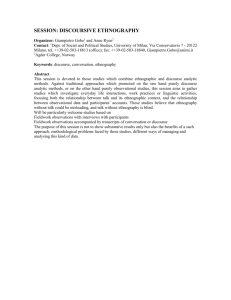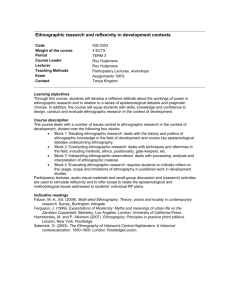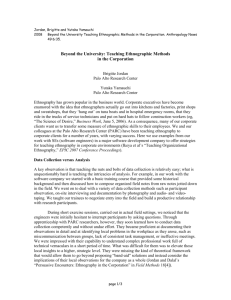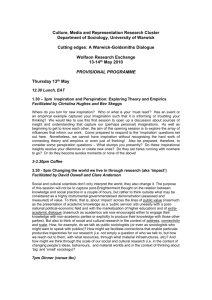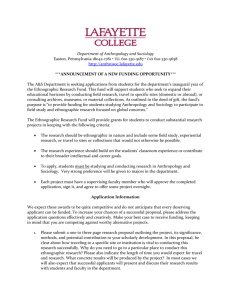Transferring Ethnographic Competence
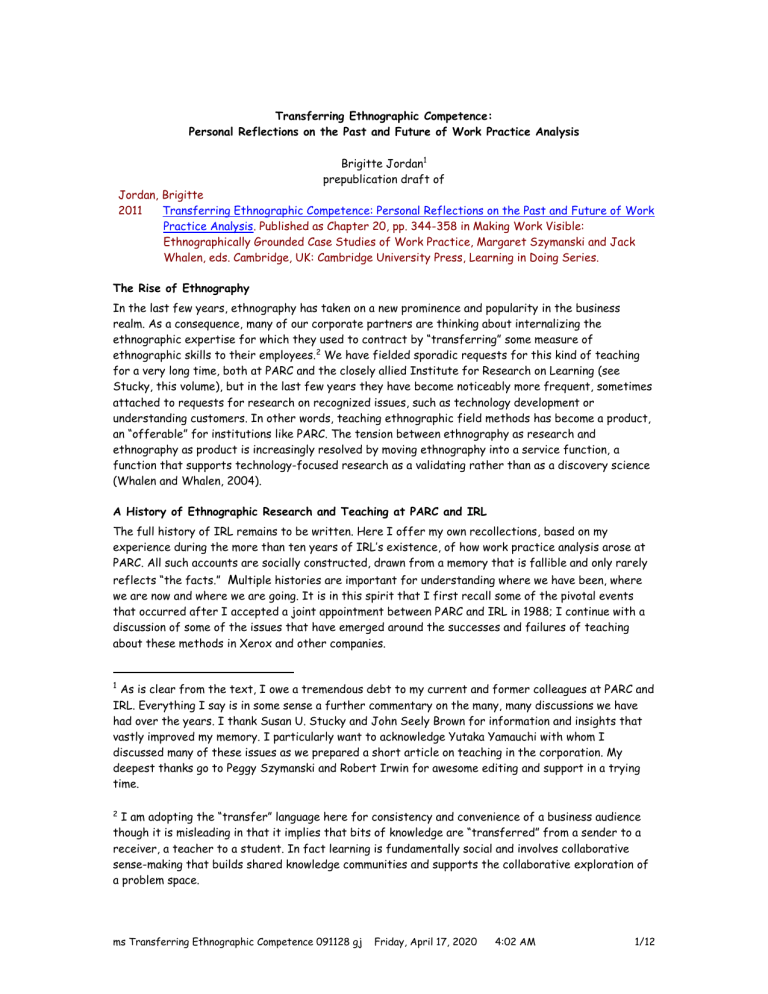
Transferring Ethnographic Competence:
Personal Reflections on the Past and Future of Work Practice Analysis
Brigitte Jordan 1 prepublication draft of
Jordan, Brigitte
2011 Transferring Ethnographic Competence: Personal Reflections on the Past and Future of Work
Practice Analysis . Published as Chapter 20, pp. 344-358 in Making Work Visible:
Ethnographically Grounded Case Studies of Work Practice, Margaret Szymanski and Jack
Whalen, eds. Cambridge, UK: Cambridge University Press, Learning in Doing Series.
The Rise of Ethnography
In the last few years, ethnography has taken on a new prominence and popularity in the business realm. As a consequence, many of our corporate partners are thinking about internalizing the ethnographic expertise for which they used to contract by “transferring” some measure of ethnographic skills to their employees.
2 We have fielded sporadic requests for this kind of teaching for a very long time, both at PARC and the closely allied Institute for Research on Learning (see
Stucky, this volume), but in the last few years they have become noticeably more frequent, sometimes attached to requests for research on recognized issues, such as technology development or understanding customers. In other words, teaching ethnographic field methods has become a product, an “offerable” for institutions like PARC. The tension between ethnography as research and ethnography as product is increasingly resolved by moving ethnography into a service function, a function that supports technology-focused research as a validating rather than as a discovery science
(Whalen and Whalen, 2004).
A History of Ethnographic Research and Teaching at PARC and IRL
The full history of IRL remains to be written. Here I offer my own recollections, based on my experience during the more than ten years of IRL’s existence, of how work practice analysis arose at
PARC. All such accounts are socially constructed, drawn from a memory that is fallible and only rarely reflects “the facts.” M ultiple histories are important for understanding where we have been, where we are now and where we are going. It is in this spirit that I first recall some of the pivotal events that occurred after I accepted a joint appointment between PARC and IRL in 1988; I continue with a discussion of some of the issues that have emerged around the successes and failures of teaching about these methods in Xerox and other companies.
1 As is clear from the text, I owe a tremendous debt to my current and former colleagues at PARC and
IRL. Everything I say is in some sense a further commentary on the many, many discussions we have had over the years. I thank Susan U. Stucky and John Seely Brown for information and insights that vastly improved my memory. I particularly want to acknowledge Yutaka Yamauchi with whom I discussed many of these issues as we prepared a short article on teaching in the corporation. My deepest thanks go to Peggy Szymanski and Robert Irwin for awesome editing and support in a trying time.
2 I am adopting the “transfer” language here for consistency and convenience of a business audience though it is misleading in that it implies that bits of knowledge are “transferred” from a sender to a receiver, a teacher to a student. In fact learning is fundamentally social and involves collaborative sense-making that builds shared knowledge communities and supports the collaborative exploration of a problem space. ms Transferring Ethnographic Competence 091128 gj Friday, April 17, 2020 4:02 AM 1/12
The early years during which PARC emerged as a leader in the application of ethnographic methods to business concerns were shaped by a close alliance between WPT (the Work Practice and Technology group at PARC) and IRL. During that time, a major factor in energizing the connection between the two institutions were the activities and ideas that emerged around the weekly Interaction Analysis
Laboratories (IALs) which I had introduced when I joined PARC/IRL. Grounded in anthropological participant observation, IALs were devoted to the analysis of video recordings from ethnographic field studies that were collaboratively micro-analyzed by an interdisciplinary group of researchers, very similar to the lab sessions Harvey Sacks had conducted at the University of California at Irvine.
The IRL/PARC labs were sometimes held at IRL, sometimes at PARC, but as a matter of policy, were open to anybody who had a video recording to be analyzed. They drew international participants as well as frequent visitors from area universities and Silicon Valley companies and were instrumental in keeping the flow of ideas in the community lively and productive.
While there was a great deal of overlap, two somewhat distinctive subcultures developed as actual work practice studies were carried out. The WPT group at PARC, under the leadership of Lucy
Suchman 3 (see Chapter 1, this volume) was more academically oriented in their analysis of data from diverse work settings, such as airports, lawyers’ offices, and bridge-building engineers. On the other hand, much of the work carried out at IRL in the 1990s focused on providing insights and recommendations to the companies that were funding IRL (of which Xerox was the most important one), something that, at the time, was disparaged in academic settings. Nevertheless there was an exceptionally productive flow of personnel and ideas between PARC and IRL that generated an extraordinarily strong alliance and collaboration.
The tight coupling between these strands of endeavor produced over the years a distinctive approach to the analysis of work practices, workscapes, and later lifescapes 4 , as well as a grounded understanding of the obstacles ethnographically based work practice studies were facing in corporations and how we could respond to them (Jordan and Dalal, 2006). In my view, the main accomplishments of the IRL/PARC collaboration during these years were two-fold:
the seminal theoretical and conceptual advances developed during that time around social learning, communities of practice (COPs), context sensitivity (situatedness), and knowledge as a collaborative achievement rather than as a collection of transferable items, and
3 Though Lucy’s degree is in anthropology, she had became very much drawn into ethnomethodology and conversation analysis, while I and other anthropologists at IRL such as Jean Lave, remained much in the tradition of anthropological ethnography that tries to understand what “the natives” around us are doing. In spite of the fact that I had studied with Sacks, Garfinkel and Schegloff, I think of myself as an anthropologist. Harvey Sacks himself had always seen CA as aligned with anthropology as much as with sociology and was preparing to do fieldwork in Mexico at the time of his death.
4 The idea of “lifescapes” came out of early work at IRL and WPT where by the early 1990s our focus on work practice studies had expanded to include the more holistic notion of “workscapes”. In a project with on-the-move high-performance executives I coined the term “lifescapes” because it became clear that work was no longer confined to work-in-the-workplace but had spread into people’s
“other” lives. The idea of “scapes” as indicating horizontal cultural conceptual domains has been publicized by Appadurai with “ethnoscapes”, Cefkin with “rhythmscapes”, and many others (Appadurai, ed. 1986; Cefkin, 2007) .
. ms Transferring Ethnographic Competence 091128 gj Friday, April 17, 2020 4:02 AM 2/12
the adaptation of anthropological research methods that had been developed in the study of exotic communities to large, technology-driven organizations.
Work practice analysis was originally internally focused, that is to say, on other parts of Xerox rather than on external clients. It began during an historic event in the late 1980s when Shirley Edwards, then VP of Real Estate for Xerox, came to PARC to conduct a meeting concerning facilities issues. At the meeting, I talked about how ethnographic methods could provide detailed data and insights about how people actually use space as they carry out their work. I remember clearly that other attendants were distinctly nonplussed by what I had to say, probably expecting some technology-focused innovation ideas from PARC, but Shirley said “Oh, that sounds interesting. This is different.”
Shirley became an advocate for ethnographically based work practice analysis. She was excited about the potential of ethnography for furthering her own objectives (which were to “increase productivity by supporting work”) and began to look for suitable sites where that approach could be introduced into
Xerox operations. Eventually she brokered the first full-blown workplace study, the “Work Practice and Design” project at a Xerox call center in Dallas that demonstrated the value of the ethnographic approach to workplace-based issues. Ethnographic fieldwork produced recommendations for building a new call center that informed the design and layout of work spaces for productivity and employees’ enjoyment, and generated proposals for redesigning Xerox training programs.
5 While there was then no explicit effort to transfer ethnographic methods to the participants as part of our research, our presence and activities over more than a year implicitly carried the message that the desired transformation to a “learning organization” would need to be grounded in a deep understanding of employees, their work practices, and concerns.
Significantly, this project was also our first opportunity to introduce and demonstrate the power of video-based Interaction Analysis to call takers and their trainers, an effort that taught them to “see the invisible” and generated insights about many of the issues inherent in their work (Bishop et al.
1994). We regularly invited call center workers to “pizza lunch meetings” where we showed video tapes of the calls they had dealt with, maybe just the day before. Looking at themselves at work and being able to talk about what they did was inherently interesting to them and with some support from us (we often pointed out things that they didn’t see) gained insight into the ways in which the technologies and resources available at their workstations supported their work practices (or not). They became analysts of their own work. Out of this came employee-based initiatives to generate change, some of which were favorably received by management. As a result, the call center trainers began to experiment with incorporating video in their repertoire, out of which emerged standards for what should be taught to novice call center workers. The trainers became strong advocates for using collaborative video analysis for coming to a useful understanding of work practice issues. This was in effect a kind of indirect methods transfer and was successful largely because it directly dealt with the trainers’ issues.
During these projects, almost without noticing it, we regularly found ourselves attaching methods instruction to the discussions about research issues. Those instructions in many cases became workshops and courses. In other cases, they became routine instructional components of joint research meetings, as for example in a project with Nynex Science and Technology where methods
5 In this first large project William Clancey and I were co-Principal Investigators (Bishop et al. 1994).
Shirley Edwards also funded the continuation of this project at the new call center in Lewisville (see
Chapter 11, this volume) as well as the Systemic Assessment Project at Xerox Business Services
(where we partnered with an entire Xerox business division in a large-scale effort to create a learning organization (Aronson et al., 1995). ms Transferring Ethnographic Competence 091128 gj Friday, April 17, 2020 4:02 AM 3/12
discussion became an expected part of every research meeting that IRL- and Nynex-based researchers carried out. This period also saw the development of a number of project reports, white papers, and later journal publications that explained our approach and methods (Blomberg et al., 1993,
Button et al., 2003, Jordan, 1996, Jordan, 1997, Suchman and Trigg, 1991).
Building on the experience and confidence we had gained with early internal, Xerox-embedded efforts, we eventually branched out, developing a number of more or less formal course and workshop offerings that were designed to help large organizations develop internal ethnographic competence. A final step in this direction was the development of methods learning centers in PARC client companies
(Kishimoto and Whalen, this volume; Plurkowski et al., this volume).
What then are the main issues for embedding ethnographic competence that emerged during this long and complex history? How can we teach employees who often have minimal background in research about the benefits (and limitations) of using ethnographic field methods? I draw on my work and that of my colleagues at PARC and formerly at IRL to suggest that three levels of knowledge transfer need to be considered: expertise in basic field methods; analytic competence; and, ideally, strategic relevance. I will discuss these in turn.
Level-1: Basic Field Methods at the Toolkit Level
Field methods epitomize the craft of ethnography. The bulk of the teaching to “transfer ethnographic expertise” is on the level of techniques. It is comparatively easy to teach and to learn the craft of ethnography and such teaching shows impressive results in a short time. It provides basic grounding that differentiates ethnography from other research methods, especially focus groups and predesigned surveys. The goal of a first learning engagement is thus to provide corporate learners with a toolkit from which they can choose data collection techniques for their projects.
A typical course of several days begins with historical background, i.e. the transformation from exotic anthropological “jungle ethnography” to company-relevant “business ethnography”. Often a discussion is also required upfront in order to establish research as a data-based attempt to answer questions.
From this emerges a grounding conversation about what kinds of data can answer what kinds of questions, leading to an appreciation of what ethnography can and cannot do.
Since we are convinced that most learning happens in the doing, our courses and workshops are interactive, experiential and collaborative and often include role-playing during instructional sessions.
They are built around field experiences of various lengths and complexity. We draw most materials for exercises and assignments from our own fieldwork, but often also include data that course participants contribute. For example, when somebody brought in a photograph of two friends listening to music on the same headset, a discussion about the lack of a good design for such an obvious need emerged, followed by brainstorming about what other data would be useful to understand joint headphone use. ms Transferring Ethnographic Competence 091128 gj Friday, April 17, 2020 4:02 AM 4/12
Depending on the participants’ needs, we teach and practice a variety of data collection methods, such as participant observation, on-site interviewing, documentation by photography, and audio- and video recording. The overriding goal is “learning to see” in a new way. Or phrasing it more ambitiously, reconstructing their view of the world. For example, in business environments, thinking is heavily influenced by the Six Sigma approach, a business management strategy originally developed by
Motorola. Six Sigma decontextualizes, abstracts, and aims to reduce variance. And as John Seely
Brown (JSB) points out, it is the furthest thing from situated analysis or understanding how to take advantage of these complex situations. Its goal is to reduce variance while the purpose of ethnographic participant observation is to understand variance (Interview with JSB, August 27, 2009 by Peggy Szymanski).
For a while participants may continue to see themselves as objective outside observers— as data collection machines that document sites, events and interactions objectively rather than as participant observers, continuing to attempt to embody the ideal of deductive, laboratory science
(Jordan and Yamauchi, 2008). This attitude is particularly pronounced in those whose training and work experience tends to reduce reality into abstract structures, consisting of boxes and arrows, as in the ubiquitous workflow diagrams. Such representations allow only a yes/no dichotomy without gradations, representing flow as a sequence of on/off states with no grey areas. Teaching ethnographic work practice analysis, even on a fundamental level, works towards counteracting such ingrained ways of seeing problem and solution spaces.
Throughout our teaching sessions we focus on signal topics that are particularly important in ethnography such as how to build trust with research participants (critical for effective participant observation), or that distinguish it from other approaches, such as the difference between lived
“practice” and documented “process.” We emphasize the fact that what people say is not necessarily what they do (often leading to a discussion of the proper and improper uses of focus groups), and the emic/etic or insider/outsider perspective (distinguishing between data collected from the point of view of study participants and those that are based on the categories the analyst brings in from the outside). We attempt to instill in participants the idea that the ethnographer needs to assume the role of learner, of student, and as much as possible, of apprentice. We might illustrate emic/etic issues for example by pointing out that for understanding the work of pilots from an informed experiential view it would be useful to learn to fly, but it would also be good to complement participant observation by listening to an experienced pilot talk about the typicality, normality, general pervasiveness (or lack thereof) of the activities observed. ms Transferring Ethnographic Competence 091128 gj Friday, April 17, 2020 4:02 AM 5/12
We pay particular attention to the importance of systematic (rather than impressionistic) data collection and ways of achieving that, for example by constructing team-shared templates for transforming raw notes from the field into data usable for analysis. This then opens up a discussion of top-down vs. collaborative approaches to data collection and, more recently, the use of communication and collaboration technologies (cell phones, cameras, email) for transforming “informants” into collaborating, data collecting research colleagues (see Schiano and Bellotti, this volume).
One essential component of teaching basic data collection is instilling in novice ethnographers a serious respect for the ways in which biases of various sorts can affect their work (Convertino et al.,
2009). In today’s business world where we are frequently called upon to investigate interaction between (often globally) distributed workgroups, understanding what is known as the fundamental attribution error (Cramton, 2002:193) is of particular relevance. But the general idea here is to build a constant attitude of bias vigilance, including biases that are personal and grounded in participants’ experience and life history. The slogan here is: know thyself!
Embedding ethnography in corporations is an exercise in culture change that almost always relies on rephrasing questions, reformulating metaphors, and surfacing deep-seated attitudes that can interfere with the research process. For many people, the idea that reality is simply “out there” to be described and that analysis should be researcher-independent is deeply ingrained, while we argue that this kind of analysis is inappropriate for workplace studies because workplaces are dynamic everchanging organic systems where it is impossible to control for variance.
Learning ethnographic techniques at this level produces a valuable close-grained documentation of what “really” is going on in the workplace (something that many managers are not aware of). It also allows identifying local problems and suggesting local solutions. For participants, such courses or workshops are immensely satisfying because of the resources they make accessible for “seeing differently” and the insights they generate rather quickly.
Level-2: Teaching and Learning Deep Analytic Competence
It is comparatively easy to teach Level-1 ethnographic techniques, and companies readily see the value of having ethnographically informed members in their midst. What is much more difficult to teach is full analytic competency. In order to develop the ability to relate patterns emerging from field data to company-relevant issues, deep analytic competence is required that can draw on theory and general concepts that are applicable beyond the local fieldsite. For some companies, toolkit level competence is not enough. For example, fieldwork may reveal that employees spend too much time in meetings, leading to a bullet list of recommendations for overhauling meeting rules and meeting technologies.
This is certainly useful but such local stopgap (“bandaid”) solutions do not touch the company’s larger issues which have to do with what kind of work these meetings need to accomplish and why so many meetings exist in the first place.
And so some companies recognize that for addressing systemic, enterprise-wide problems, a higher level of competence is required. This requires for both teachers and learners a move from mere observation of interaction in time and space to a structural level, where one might ask: what is it in the system that spawns the issues we observe in the field? In other words, how can we move from the specific, local, observable, to the general? Companies do want to fix local problems, but the big payoff comes for them when issues can be identified at a higher level, that is to say, are generalizable to a larger universe, e.g. all of the company’s call centers, or all call centers within the industry, maybe including competitors. This is the promise of deep analytic competence.
Still, why is teaching analytic competence so difficult? ms Transferring Ethnographic Competence 091128 gj Friday, April 17, 2020 4:02 AM 6/12
Professionally trained anthropologists typically acquire analytic skills during years of graduate education that include multiple stints of fieldwork. During that time they live within a community of similarly engaged fellow graduate students while coming under the increasingly close supervision of one or more major professors. A part of this process consists of an intensive study of prior expert thought and opinion (“the literature”), both in heads-down cramming sessions and in seminar conversations that link students’ emerging ideas to the history of their field and allow them to draw on patterns and insights from that literature.
After seeing, reading and hearing about a sufficient number of examples, students learn to recognize and classify them. They learn to determine which elements of the situation or domain must be treated as important and which can be ignored (Dreyfus, 2009). In the academic context, this selection is shaped by the history and current interests of the discipline in which the student is embedded. The important aspects of this stage are repetition, critical positive relationships with superiors and fellow students, and fitting methods, topics, and insights progressively into those of their professional community. But for competent analysis in the world of work, it is company-specific interests and features of the work culture that provide the analyst with the criteria for deciding which of the many possibly relevant features they should take up. In contrast to “pure research” in which analysis is often focused on abstract anthropological or sociological topics, corporate ethnography is responsive to the interests of the company.
The institutional resources inherent in a professional graduate program are mostly lacking in the corporate environment. The question then is whether similar analytic skills can be conveyed to nonacademics during a comparatively brief training period. Are there approaches that could approximate the kind of in-depth learning that happens in graduate school education? We have given considerable thought to this issue and have devised a series of interventions and experiments that can grow some measure of analytic skill at a substantially faster pace than traditional graduate school attendance.
We identify three basic requirements: participation in an ethnographic community of practice, the opportunity to acquire experience with knowledgeable mentors, and involvement with an appropriate body of literature.
Experience shows that a single individual cannot be taught to attain full analytic competence. While methods-trained employees should be able to collect data on their own, for the analysis of such data to show systemic results, it has to be vetted by a community. Popular culture still champions the
Marlboro Man’s solitary excursions (reflected in academic promotion criteria and corporate performance appraisals) but analytic competence is really a “team sport” in the sense that it requires a community within which analytic competence is encouraged and supported. It is through exposure to different kinds of analysis, considerable field experience, a tradition of group reflection and sustained participation in collaborative analysis sessions that analytic skills develop. For this, a key requirement is constant mutual mentoring within the group as well as one-on-one mentoring that pairs novices with experienced researchers over the length of an entire project.
To learn to actually do analysis requires periodic but frequent collaborative data mining sessions during which trainees analyze their fieldnotes, sketches, recordings, photographs, documents and other collaterals, exploring multiple data strands through insistent questioning. It is here that participants ask each other questions like: What do you see? What would somebody else see? What are you looking for? What else could you be looking for? How do we know this? What evidence do we have? Where else could we look for evidence? Has anybody else explored this question? Routinely engaging in this exercise (as we did in the IALs) opens up linear thinking to considering other options, causes and influences, and tracks the flow of knowledge, people and technologies that keeps systems interconnected. ms Transferring Ethnographic Competence 091128 gj Friday, April 17, 2020 4:02 AM 7/12
One outcome of communal data analysis sessions is that analysts learn to respect empirical data. It is here that the common human tendency to speculate, to make sense of the world by imputing motives and causes, can be overcome through an insistence on honoring the data. It is in these sessions that trainees learn to always go back to the data in order to hold unbridled conjecture in check. This ability to step back from current hypotheses and explanations is precisely what differentiates an analyst from a person with opinions. In the IALs there was an often-enforced rule: when a video was stopped for comments, nobody could talk for more than five minutes without going back to the data by turning the tape back on. This fosters reliance on thinking about what the real world is telling us and starves unrestrained flights of fantasy. In the long run, this should lead to developing what we might call the ethnographic stance: an attitude that simultaneously honors data and theory by pulling in concepts and patterns and checking them against the data that have been collected. Built on reflection and repetition, it is these group analysis sessions that are a major factor for growing fledgling analysts’ expertise in pattern recognition. Video is especially helpful in this regard. In addition, guided reflexive exposure to relevant articles is remarkably effective in establishing common analytic ground among members of ethnographic teams.
It must be recognized that companies who aspire to this level of ethnographic competence need to understand that they must commit two crucial resources for this enterprise: time and money. Unless they are prepared to invest both they might be better off reaping the substantial benefits of a Level-
1 transfer.
Level-3: Growing Strategic Competence
Let me say up front that at the strategic level the transfer metaphor breaks down completely.
Strategic competence means to have significant influence at the top level of the company to the point of changing the company’s culture. This requires a group of ethnographers who are committed to upgrade their influence on higher level company goals and presupposes a cohesive group of ethnographic experts, an “ethno-team”, who have acquired a deep understanding of the company’s work culture. Some of its members would probably be in-house or at least have become deeply embedded in the target company during an extended period of work. Thus strategic competence cannot be taught, it has to emerge almost naturally from the prior two levels of competence, fueled by the vision of an ethnographically trained core group that aspires to optimize the impact of ethnography at the strategic level. It requires a sophisticated understanding of the micro-political climate and skill in the corporate dance that allows the team to navigate simultaneously within the macro-organizational bureaucratic structures of company politics and policies and the micro-organizational experiential world of employees and consumers that work practice analysis reveals.
The groundwork for strategic impact is buy-in within the target company. Another factor is target company ownership at all levels. We have found that in every one of our projects that were successful there was a strong connection between PARC or IRL project leader(s) and their complement in the company. Strategic projects thrive under the care of internal brokers, midwives, boundary crossers that help the project and its results acquire a social life. When projects address issues that people care about, that help them achieve their goals, then the chances for success increase. When inside ownership is lacking, excellent research simply does not make it beyond the powerpoint presentations and their reports get stuck on the credenza of the executive office.
Because of the zigzagging goal slalom, typical for corporate projects, much potentially useful information is collected but never acted upon because the parts of the company that could use it are not involved. Thus “marketing” ethnographic results, positioning ethnographic projects with the right counterparts in the client company, becomes another essential strategic activity. ms Transferring Ethnographic Competence 091128 gj Friday, April 17, 2020 4:02 AM 8/12
Finally, strategic competence requires a grounded understanding of why projects fail and what can be done to raise the likelihood of success. Our own experience parallels that of Microsoft researchers
Donna Flynn and Tracey Lovejoy who, in an insightful paper, talked about how ethnography attained strategic influence at Microsoft (Flynn and Lovejoy, 2008). They suggest that a major success factor is alignment of ethnographic research with the company’s product development cycle and propose that ethnographic work should begin well before technology gets started in order to provide designers with relevant data from the field.
6 Ethnography at the strategic level fails when ethnographic projects are
(or become) misaligned with the client company’s top level objectives and business initiatives. Most ethnographic projects draw on Level-1 and Level-2 competence. They are concerned with product or customer characteristics. To achieve strategic competence, however, a plan for phased strategic engagement has to be put in place that looks at the deployment of ethnographic projects over the company’s product cycle, creating a strategic engagement model for ethnography with a vision of endto-end research across the product cycle that aligns customer understanding with product strategy.
The truth is that in our experience strategic success has rarely happened. In the early days, anthropologically-based ethnography had an almost strategic function under JSB. Our mere presence made it necessary to take the social into consideration and thereby changed the nature of the dialogue at PARC. This was a fortunate constellation that provided the space for us to mature our academically grounded field methods into a work practice methodology that became enormously influential in corporate research.
Conclusion
So what is the future of ethnography and work practice analysis in the workscapes and lifescapes of the twenty-first century? I envision at least two scenarios: The first sees ethnography splintering -- fragmenting into an assortment of free-standing techniques that are sold to the market place; the second sees ethnography expanding and extending its reach from workscapes to lifescapes and beyond.
It is undeniable that along with the rise in requests for competence transfer has come an expanding number of providers eager to respond to the demand. With widespread lack of understanding of what ethnography can and cannot do, it has become de rigueur to splice in an “ethnographic component” whether a project needs it or not. Specialization may concentrate aspects of our praxis in practitioners helping clients interpret complex data about complex situations.
But it may also pull the life blood out of what makes ethnography compelling, potentially leading to ethnographic piece work, deskilling and theoretical anemia.
Unavoidably some of these practitioners are not well trained and operate with minimal experience.
Data collection becomes commoditized (Lombardi, 2009) as methods are unpacked and practitioners claim expert status in this technique or that. But there is a difference, too often ignored, between adapting traditional anthropological methods in all their richness and the claiming of expert status that all too often relies on rote application of one or more techniques. Unfortunately, splintering has led to less than optimal uses of ethnography as pieces of a coherent approach are isolated and sold to the market as ethnography. A prime example is video ethnography, originally a type of data collection and analysis that has deep theoretical and practice foundations (Jordan and Henderson, 1995). In
6 A key insight of Microsoft ethnographers is that in their environment they need to build knowledge of target customers and product opportunities 12 to 36 months ahead of corporate product teams in order to have relevant information ready when the project actually starts up. This of course means that the e-team must have access to corporate initiatives in the pre-deployment stage in order to strategically position such projects. ms Transferring Ethnographic Competence 091128 gj Friday, April 17, 2020 4:02 AM 9/12
some applications, this has deteriorated into “video bites”, the equivalent of voice bites that merely serve to illustrate and validate some predetermined conclusion. Thus video has become more of a marketing tool that builds familiarity with internal and client stakeholders that has little to do with discovery ethnography. It does not enable finding out something new, but merely validates previously determined issues.
The second futures scenario is about expansion. We started, now so many years ago, with taking on work and learning as serious research foci and called what we did “work practice analysis.” We have retained the label even though we came to realize it was too restrictive. We were, after all, analyzing much more than people’s work practices, their actions, what they did in the workplace; we were also looking at how they used space and time, how they lived and shaped the culture of their organization, and how the tools they used were part and parcel of how they worked. What we studied looked more and more like a landscape that had varying features and areas of interest through which one could take many different paths. And so we started to think of ourselves as doing “workscape analysis.”
Eventually, our studies morphed into what I called “lifescapes” analysis because it became clear that work has become mobile, that it is now spatially and temporally distributed all over people’s lives
(Meerwarth et al., 2008). The boundaries between worklife and private life had indeed begun to fade.
My conviction is that once ethnography manages to get beyond the current hump of outsized claims and faddish popularity, we will again be able to “adapt and adopt” time honored ethnographic methods and approaches to a changing world. This is truly where work practice analysis belongs.
References
Appadurai, Arjun, ed.
1986 The Social Life of Things: Commodities in Cultural Perspective, New York: Cambridge
University Press.
Aronson, Meredith, Libby Bishop, Melissa Cefkin, Brigitte Jordan, Nancy Lawrence, Lindy Sullivan,
Connie Preston and Julia Oesterle
1995 Reflections on a Journey of Transformation: Learning, Growth, and Change at Xerox Business
Services. Final Report on the XBS Systemic Assessment Project, Institute for Research on
Learning, Menlo Park, Ca.
Bishop, Libby, Melissa Cefkin, William Clancey, Brigitte Jordan, Julia Oesterle and Beth Tudor
1994 A Learning Organization in the Making: A Report on the WorkPractice and Design Project at the Xerox CAC in Dallas. Menlo Park, CA: Institute for Research on Learning.
Blomberg, Jeanette, Jean Giacomi, Andrea Mosher, and Pat Swenton-Wall
1993 Ethnographic field methods and their relation to design. In Participatory design: principles and practices, ed. Douglas Schuler and Aki Namioka. Hillsdale: Lawrence Erlbaum Associates.
Button, Graham et al.
2003? The Work Practice Consultancy Tool Kit. needs correct ref with co-authors. URL or unpublished ms? For me, reading this was a waste of time. There is little in there that is practically useful for data collection.
Cefkin, Melissa
2007 Numbers May Speak Louder than Words, but Is Anyone Listening? The Rhythmscape and
Sales Pipeline Management. Proceedings of EPIC 2007: 188-199.
Convertino, Gregorio, Dorrit Billman, Peter Pirolli, J.P. Massar and Jeff Shrager ms Transferring Ethnographic Competence 091128 gj Friday, April 17, 2020 4:02 AM 10/12
2008 The CACHE Study: Group Effects in Computer-supported Collaborative Analysis. Computer
Supported Cooperative Work 17:353-393.
Cramton, Catherine Durnell
2002 Attribution in Distributed Work Groups. PP. 191-212 in Distributed Work, Pamela Hinds and
Sara Kiesler, eds. MIT Press. Cambridge, MA.
Dreyfus, Hubert
2009 On the Internet. 2. Edition. London and New York: Routledge.
Flynn, Donna and Tracy Lovejoy
2008 Tracing the Arc of Ethnographic Impact: Success and (In)visibility of Our Work and
Identities. Proceedings of EPIC 2008, p. 238-250.
Jordan, Brigitte
1997 Transforming Ethnography -- Reinventing Research. Cultural Anthropology Methods Journal
(CAM) 9:3: 12-17 (Oct).
Jordan, Brigitte
1996 Ethnographic Workplace Studies and Computer Supported Cooperative Work. Pp. 17-42 in:
The Design of Computer-Supported Cooperative Work and Groupware Systems. Dan Shapiro,
Michael Tauber and Roland Traunmüller, eds. Amsterdam, The Netherlands: North
Holland/Elsevier Science.
Jordan, Brigitte and Brinda Dalal
2006 Persuasive Encounters: Ethnography in the Corporation. Field Methods 18:4:359-381.
Jordan, Brigitte and Austin Henderson
1995 Interaction Analysis: Foundations and Practice. The Journal for the Learning Sciences 4:1:39-
103.
Jordan, Brigitte and Yutaka Yamauchi
2008 Beyond the University: Teaching Ethnographic Methods in the Corporation. Anthropology
News 49:6:35.
Lombardi, Gerald
2009 The De-Skilling of Ethnographic Labor: Signs of an Emerging Predicament. Pp. 41-49 in
Proceedings of EPIC 2009.
Meerwarth, Tracy, Julia Gluesing and Brigitte Jordan, eds.
2008 Mobile Work, Mobile Lives: Cultural Accounts of Lived Experiences. Wiley-Blackwell and
American Anthropological Association (NAPA Bulletin 30).
Suchman, Lucy and Randall H. Trigg
1991 Understanding Practice: Video as a Medium for Reflection and Design. In Design at Work:
Cooperative Design of Computer Systems, J. Greenbaum and M. Kyng, eds. Hillsdale: Lawrence
Erlbaum Associates.
Whalen, Marilyn and Jack Whalen
2004 Studying workscapes. Pp. 2080229 in Discourse and Technology: Multimodal Discourse
Analysis, Philip LeVine and Ron Scollon, eds. Washington, DC: Georgetown University Press. ms Transferring Ethnographic Competence 091128 gj Friday, April 17, 2020 4:02 AM 11/12
ms Transferring Ethnographic Competence 091128 gj Friday, April 17, 2020 4:02 AM 12/12

